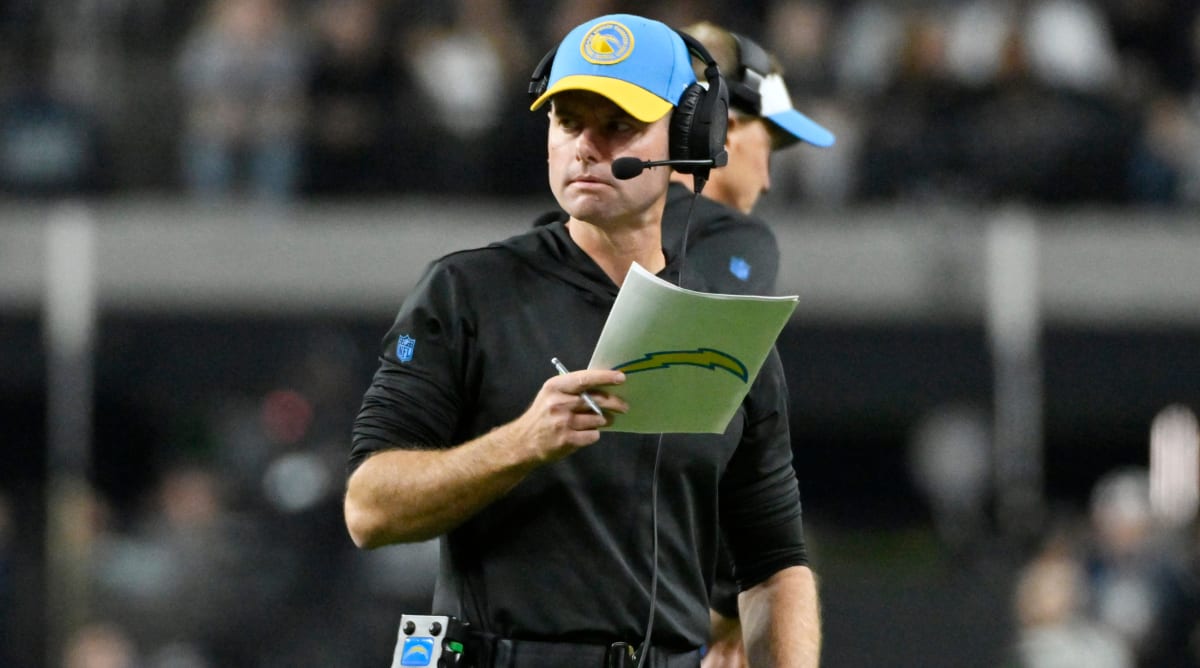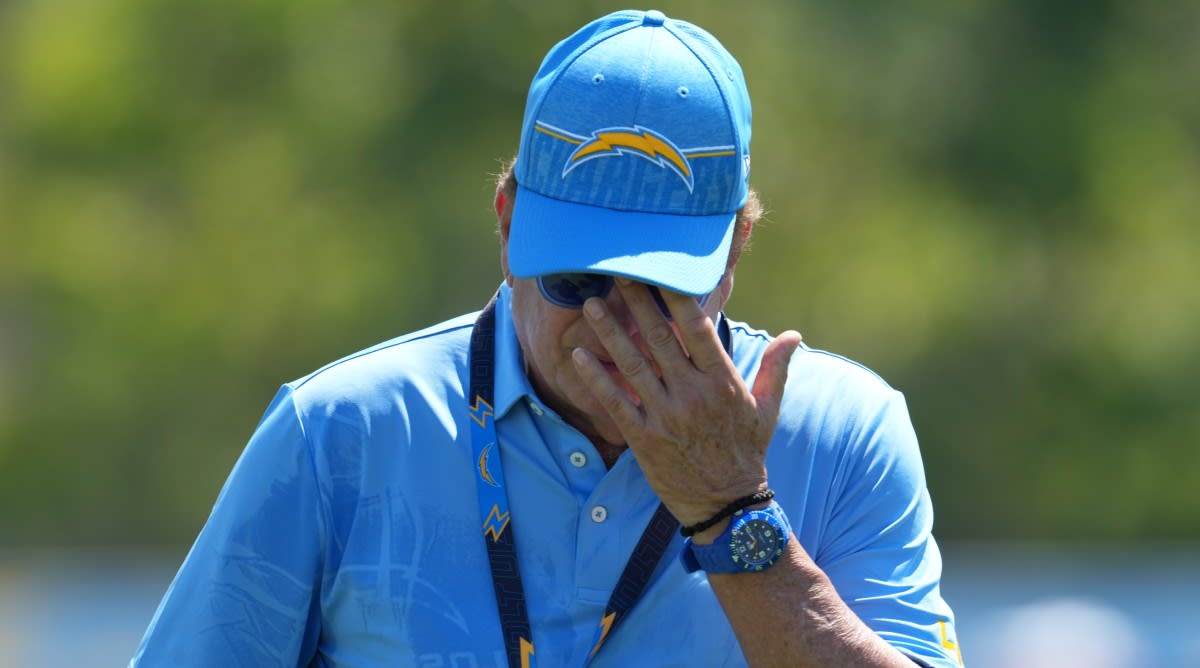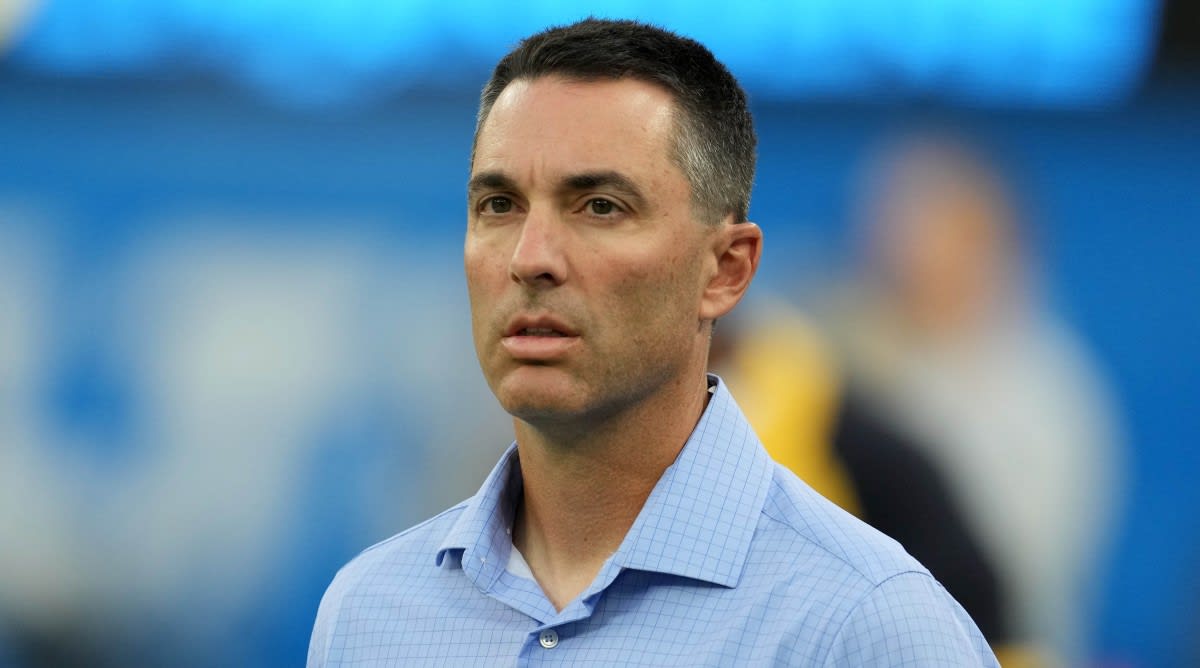As it turns out, San Diego got off easy.
San Diego was heartbroken when the Chargers left for Los Angeles after the 2015 season. It was a city which the team called home since 1961, and was ditched to become a forgettable co-tenant of the Rams at SoFi Stadium in Los Angeles.
Since the Chargers packed up and moved, they’ve reached the playoffs twice. In their most-recent trip to the postseason, they blew a 27–0 lead to the Jaguars. That was the moment owner Dean Spanos should have fired coach Brandon Staley.
If he needed further proof, he needn’t look further than the previous week, when Staley played all his starters in a meaningless Week 18 game at Denver, only to see star receiver Mike Williams fracture his back.

David Becker/AP
Still, Spanos retained Staley instead of making an offer to Sean Payton, a Super Bowl–winning coach who by all reports was interested in staying at his home in Los Angeles and coaching Justin Herbert.
Of course, Payton wasn’t going to come cheap. Alas, off to the Broncos he went for a reported five years and $80 million.
With Staley now in his third year, Los Angeles is a pitiful 5–9 with three losses to go. This disaster was punctuated by a national embarrassment on Thursday night, losing 63–21 to the Raiders.
Whether on Friday or after the season, Staley will mercifully be gone. The fans the Chargers still have will then steel themselves for the next hiring cycle, one that will include hope of a young coach wanting to align himself with Herbert’s prodigious right arm.
The problem is Spanos, who has been unwilling to pay coaches. Don’t expect that to change now.
In Staley, the Chargers got a young, relatively inexperienced assistant from the Rams. He was a defensive coordinator with the Rams for a single season before switching locker rooms at SoFi. In short, a cheap, sellable move.
And hey, the Chargers saved on relocation costs.
In that same hiring cycle, Nick Sirianni and Dan Campbell were available. Los Angeles also could have promoted Shane Steichen from offensive coordinator after Herbert put forth the most statistically impressive rookie season in NFL history for a quarterback, with 4,336 passing yards and 31 touchdowns.
Steichen would have been perfect. He had been with the Chargers for nine years over two stints, would have been inexpensive and would have continued to work beautifully with Herbert.
Instead, Steichen ended up in Philadelphia, where he helped transform Jalen Hurts into an All-Pro. Now, Steichen is the Colts’ head coach, where his undermanned Indianapolis team is 7–6 and fighting for a playoff spot.
Of course, penny-pinching and poor decisions are nothing new to the Bolts.
Los Angeles’s hires before Staley were Anthony Lynn and Mike McCoy. Again, two lifetime assistants who weren’t going to command major dollars. And, in true Chargers fashion, neither worked out. They combined for a 60–68 record with one postseason victory each.

Kirby Lee/USA TODAY Sports
Under the Spanos family—Dean’s father, Alex, bought the team in 1984— the Chargers have hired 11 coaches, not including interims. Of them, only Dan Henning, Marty Schottenheimer and Norv Turner had previous NFL head-coaching experience.
Schottenheimer worked out splendidly, leading then San Diego to a 14–2 record and the No. 1 seed in the AFC in 2006. Yet the Chargers were upset by Tom Brady and the Patriots, and Schottenheimer was fired afterward.
Fast forward to the present, and the Spanos family will soon be making its 12th hire. The hot names will include Lions offensive coordinator Ben Johnson, Ravens defensive coordinator Mike Macdonald, Patriots coach Bill Belichick, Michigan coach Jim Harbaugh, 49ers defensive coordinator Steve Wilks and others.
Harbaugh and Belichick will be the most expensive, so despite the former playing for the franchise from 1999 to 2000, likely rule them out.
Johnson is the biggest name of the rising stars, but while Herbert and a potential top-10 pick are enticing, would he go to a team with a looming cap crunch, an aging roster and a questionable ownership group?
History says another coach will be getting his first shot. And while the Chargers can sell the weather, the quarterback and the city, they can’t sell anything else.
There is no home-field advantage, no culture and no clue.
Oh, and Patrick Mahomes is in the division.
Furthermore, Spanos can’t just stop at Staley when it comes to the housecleaning. Tom Telesco has been the general manager since 2013, a feat which should be studied by historians given his lackluster tenure.
Telesco has an 84–91 mark across 11 seasons, which has seen more coaches (three) than double-digit win campaigns (two). Over that span, the Chargers have three playoff appearances, two postseason wins and zero AFC West titles, the last of those having come in 2008.
In the draft, Telesco has been decent in the first round, nabbing Joey Bosa, Mike Williams, Derwin James, Rashawn Slater and Herbert. However, he’s also missed woefully with D.J. Fluker and Jerry Tillery.

Kirby Lee/USA TODAY Sports
But it’s the rounds afterward which have been a masterclass in ugliness. In Telesco’s career, he has selected 58 players (not including the 2023 class). Of those men, only two—Keenan Allen and Denzel Perryman—have made a Pro Bowl.
All of these poor choices have left the Chargers in this moment.
They’re a team without a true home, a roster without a supporting cast for its wunderkind quarterback and a franchise adrift, as it has been so often since unceremoniously firing Schottenheimer after posting the best record in team history.
In the coming days or weeks, the Chargers will make the easy move. They will fire Staley and potentially Telesco, the former being gone a year too late.
They’ll call a press conference and sell the notion of hope and change, or a new day. They’ll talk about the idea of things being different.
But for the Chargers, the only thing that’s changed over the last decade-plus is the city they call home.
And for San Diego, what once was a painful moment now appears a reprieve.







